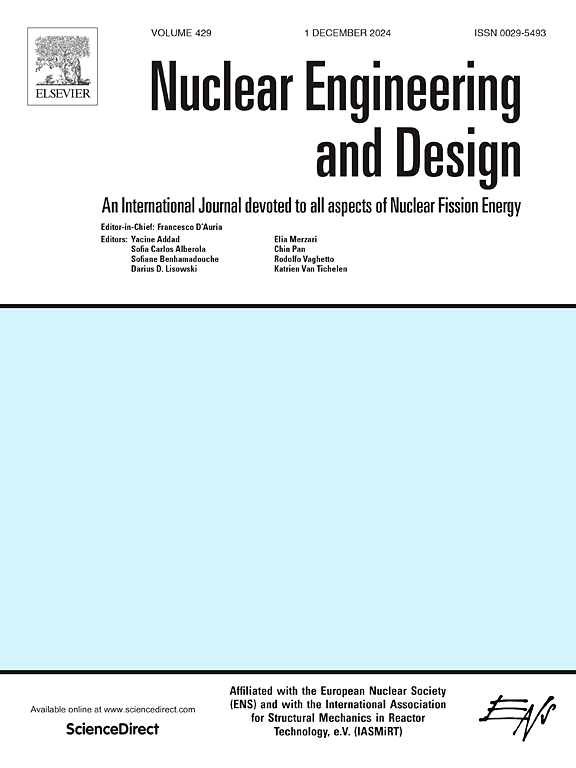Pareto front of sodium void worth and breeding ratio in metal-fueled sodium fast reactor with axially heterogeneous core design by coupling neutronics and genetic algorithm
IF 1.9
3区 工程技术
Q1 NUCLEAR SCIENCE & TECHNOLOGY
引用次数: 0
Abstract
For sodium-cooled fast reactors (SFRs), achieving low sodium void worth (SVW) and flexible breeding ratios (BR) is crucial. This study establishes a method coupling neutronics simulations with genetic algorithms (GA) and applies it to a 3000 MWth metal-fueled SFR to optimize the SVW, BR, and the power distribution of axially heterogeneous cores. The Pareto front, i.e. optimal front, between SVW and BR is determined, quantitatively clarifying the trade-off relationship between these two parameters. Axially heterogeneous cores with equal inner and outer fissile heights can achieve SVW adjustments from −71 to 3148 pcm and BR adjustments from 1.26 to 1.62. Designs with unequal fissile heights slightly expand the feasible region, but the impact on the optimal front for equal-height designs is limited. Through the analysis of the spatial distribution of the sodium void effect, it is shown that the bond sodium model significantly influences the SVW in low sodium void cores, while its impact on high breeding cores is minimal. The results indicate that the power distribution can be optimized by adjusting the enrichment of subregions within the constraints of SVW and BR. For low sodium void cores, retaining a certain amount of lower fertile material is necessary to flatten the power distribution. While the criticality search during depletion calculations affects the parameters, its impact on identifying the optimal front is limited.
通过耦合中子学和遗传算法计算金属燃料钠快堆轴向异质堆芯设计中钠空隙值和孕育比的帕累托前沿
对于钠冷快堆 (SFR) 而言,实现低钠空隙值 (SVW) 和灵活的繁殖比 (BR) 至关重要。本研究建立了一种将中子模拟与遗传算法(GA)相结合的方法,并将其应用于 3000 MWth 金属燃料 SFR,以优化 SVW、BR 和轴向异质堆芯的功率分布。确定了 SVW 和 BR 之间的帕累托前沿(即最优前沿),定量阐明了这两个参数之间的权衡关系。内外裂变高度相等的轴向异质磁芯可实现 -71 至 3148 pcm 的 SVW 调整和 1.26 至 1.62 的 BR 调整。裂变高度不等的设计略微扩大了可行区域,但对等高设计的最佳前沿影响有限。通过分析钠空隙效应的空间分布,可以看出键钠模型对低钠空隙堆芯的 SVW 有显著影响,而对高孕育堆芯的影响则微乎其微。结果表明,在 SVW 和 BR 的约束条件下,可以通过调整子区域的富集度来优化功率分布。对于低钠空心来说,保留一定量的低可育性物质对于平缓功率分布是必要的。虽然耗尽计算过程中的临界搜索会影响参数,但其对确定最佳前沿的影响是有限的。
本文章由计算机程序翻译,如有差异,请以英文原文为准。
求助全文
约1分钟内获得全文
求助全文
来源期刊

Nuclear Engineering and Design
工程技术-核科学技术
CiteScore
3.40
自引率
11.80%
发文量
377
审稿时长
5 months
期刊介绍:
Nuclear Engineering and Design covers the wide range of disciplines involved in the engineering, design, safety and construction of nuclear fission reactors. The Editors welcome papers both on applied and innovative aspects and developments in nuclear science and technology.
Fundamentals of Reactor Design include:
• Thermal-Hydraulics and Core Physics
• Safety Analysis, Risk Assessment (PSA)
• Structural and Mechanical Engineering
• Materials Science
• Fuel Behavior and Design
• Structural Plant Design
• Engineering of Reactor Components
• Experiments
Aspects beyond fundamentals of Reactor Design covered:
• Accident Mitigation Measures
• Reactor Control Systems
• Licensing Issues
• Safeguard Engineering
• Economy of Plants
• Reprocessing / Waste Disposal
• Applications of Nuclear Energy
• Maintenance
• Decommissioning
Papers on new reactor ideas and developments (Generation IV reactors) such as inherently safe modular HTRs, High Performance LWRs/HWRs and LMFBs/GFR will be considered; Actinide Burners, Accelerator Driven Systems, Energy Amplifiers and other special designs of power and research reactors and their applications are also encouraged.
 求助内容:
求助内容: 应助结果提醒方式:
应助结果提醒方式:


